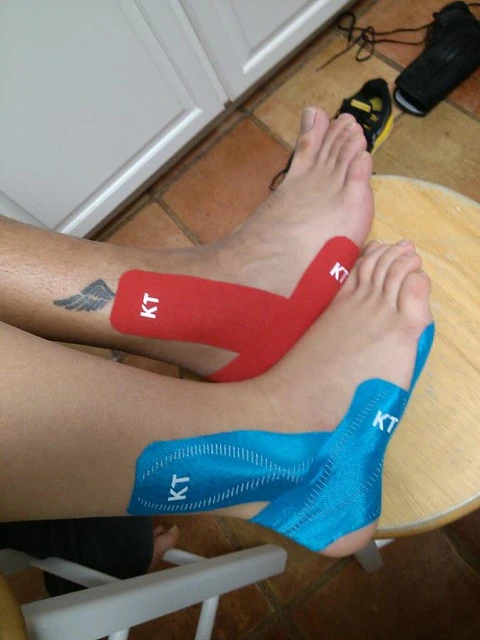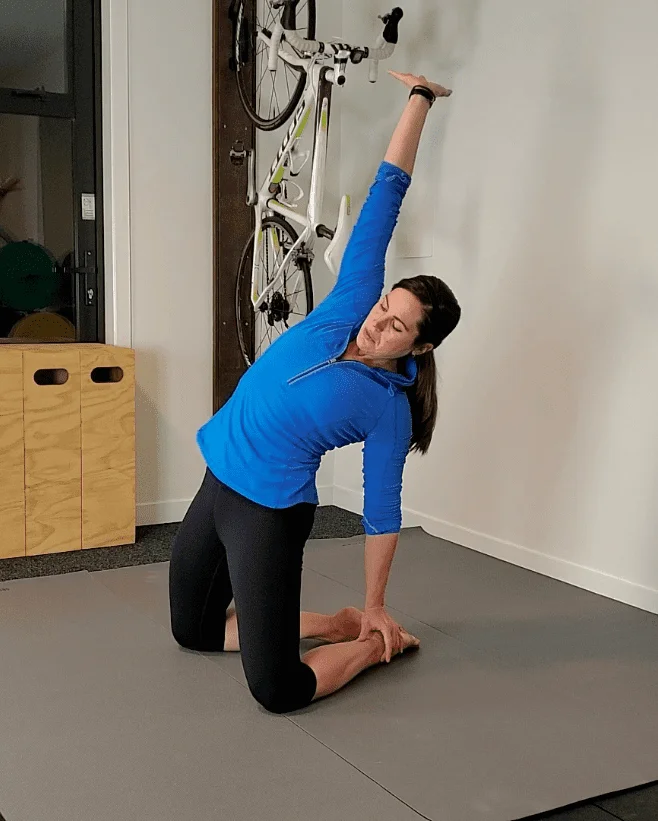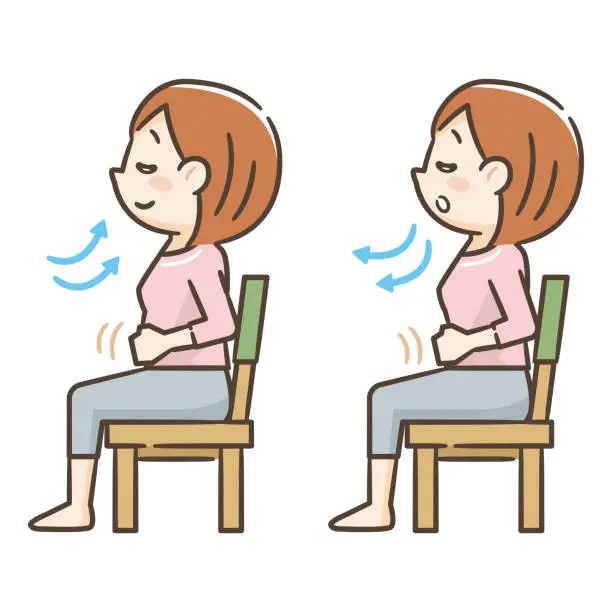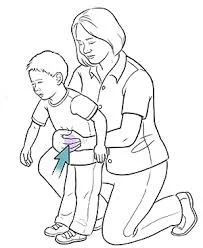How to KT Tape Your Ankle for Support and Stability
Kt tape is also known as Kinesio taping, This can be used to tape an ankle to reduce swelling and give stability. Ankle injuries are a common illness that occurs during exercise. To protect the ankle joint in the future, orthoses and tape are used.
85% of ankle injuries are sprains, and one-third of those who suffer ankle injuries do not fully recover in a year. Kt tape improves proprioception to help with balance stabilization and limit the ankle joint’s range of motion.
Kt Taping is usually utilized to restrict the motion of the weakened muscles of the injured joint to prevent further damage during continuous exercise, minimize edema, and protect and enhance the joint to prevent future musculoskeletal damage after acute injury. Furthermore, taping improves parallel forces, strength, and endurance to build workout performance ability and quick reflexes.
Elastic tape and non-elastic tape are the two main types of taping. Specifically, Kinesio tape, often known as elastic taping. A new bandage technique that is applied to the skin is called elastic kinesio taping. Because kinesio tape is thinner and more elastic than traditional tape, it produces less mechanical restraint and does not impede mobility like other methods.
Introduction
Kt tape is also called a Kinesio taping. This can be utilized to tape an ankle to reduce swelling and give stability. Ankle tape can give the ankle joint compression, stability, and support. It can reduce post-injury edema and help prevent future damage to the ankle. However, a thin line separates a properly taped ankle from one that is either too tight or doesn’t offer enough support.
In postmenopausal women with chronic venous insufficiency, kinesio-taping compression therapy improved ankle dorsiflexion during walking, gait pattern, peripheral edema, venous discomfort, and quality of life. Several theses have examined how athletes’ ankle Kinesio tape affects their ability to control their posture and ankle dorsiflexion range of motion.
Kinesio tape has been suggested to serve multiple purposes, including:
- Supporting weaker muscles to restore proper function
- Reducing congestion by enhancing blood and lymphatic fluid flow
- Reducing pain by activating the neurological system
- Realigning misaligned joints by accumulating
Benefits of Taping for Ankle Instability
The use of ankle taping has many benefits. Here are a few of the desired advantages when ankle taping is utilized correctly:
- Help in preventing the recurrence of an ankle injury, such as a sprain.
- Better proprioceptive awareness with daily activities
- Increased ankle coordination and range of motion, especially dorsiflexion, as a result of improved ankle mechanics
- Helps to improve blood flow and healing by gently lifting the connective tissue and outer layer of skin.
- Pain relief secondary to mild compression and circulatory modifications
- Helps to reduce swelling
- Improved comfort with daily tasks or sport
- Support strained ankle ligaments
- A low-cost way to assess the efficiency of a brace
- A tool to assist boost your recovery potential and overall recovery process
- Secondary advantages for any other underlying foot and ankle issues- such as calf pain, Achilles tendonitis, plantar fasciitis, and more.
In which condition of ankle kt tape is used?
Achilles tendonitis

The Achilles tendon is a connection between the heel and the calf muscles and contracts during nearly all movements, such as walking, jumping, and swimming. Although this strong tendon may take strong stresses, prolonged use can cause inflammation and pain. Tendonitis, or inflammation, and tendinosis, or degenerating tendon, are the causes of pain.
Top of foot
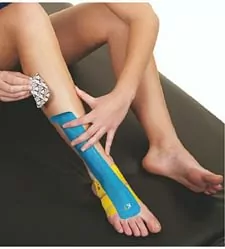
There are several bones, tendons, ligaments, and nerves at the top of the foot, all of which have the potential to become inflamed. The foot was designed for two different and inherently incompatible purposes: stability and motion.
Multiple distinct “pieces” are required to fulfill the foot’s function in the action due to this demand. The majority of everyday tasks as well as athletic efforts place a heavy burden on the feet and may result in various foot problems.
Ankle sprains
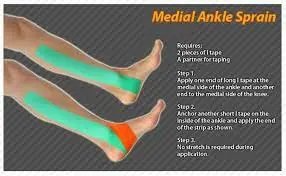
Your lower leg and foot are joined at the ankle joint. The three ligaments in your ankle prevent the bones from moving. When one of these ligaments gets detached or overextended, the result is a sprained ankle.
Heel
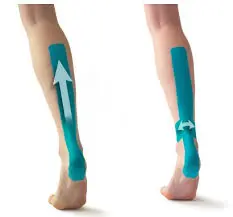
The heel is a very important part of our lives. Every step requires a lot of repetitive force, and if those steps get harder, they can cause discomfort and injury. If left untreated, the discomfort can persist for many years and lead to many additional problems. This KT Tape application can help you avoid the compensating damages that come with walking around in pain from your heel in addition to reducing the pain you experience.
Plantar Fascitis
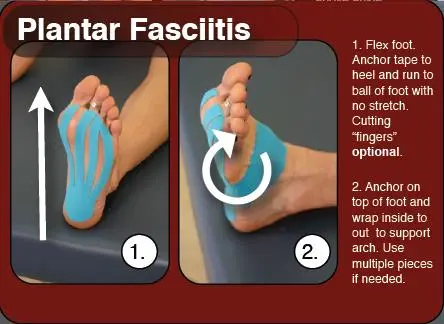
Kt tape for Plantar-Fascitis
A substantial band of connective tissue that extends from the heel to the front of the foot is called the arch tendon or plantar fascia. The medial, central, and lateral bands make up its three separate components. The area most likely impacted by plantar fasciitis pain is the middle band, which is also the strongest and thickest.
Bunion
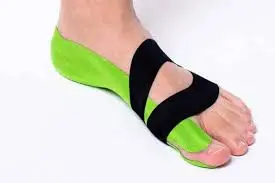
When the big toe points in the direction of the second toe, it causes inflammation of the tissue surrounding the joint, resulting in a bunion, also called hallux valgus. Jogging or walking can be quite painful because of the inflammation, which also makes the joint swollen and tender.
Peroneal Tendonitis
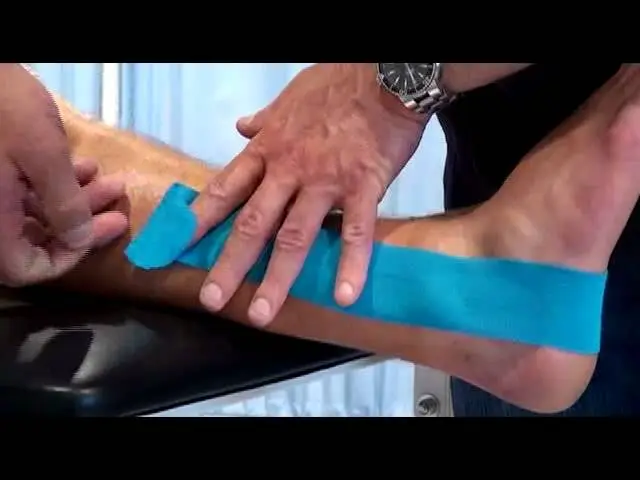
Located on the outside of the lower leg are the three peroneal muscles, which are now referred to as the fibularis muscles. Both the plantarflex and extend movements are accomplished with their assistance. Muscles and the skeletal components of the foot and ankle are connected by tendons that run behind the ankle bone.
Turf toe
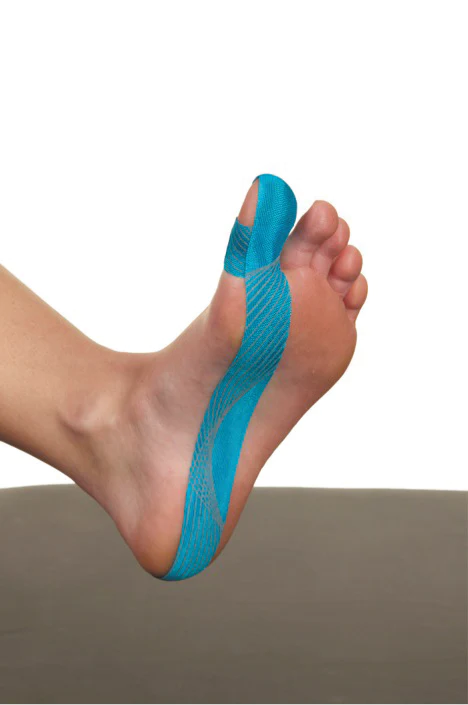
Acute or chronic hyperextension of the big toe can cause Turf Toe, a sprain of the metatarsophalangeal joint. The illness causes excruciating inflammation and bruising because it affects the connective tissue as well as the joint. Stretching and, in extreme situations, tearing of the ligaments and tendons are common.
A higher risk arises from having an ankle range of motion that is greater than normal or from wearing flexible footwear designed to grab the running surface, such as soccer cleats.
Ball of foot
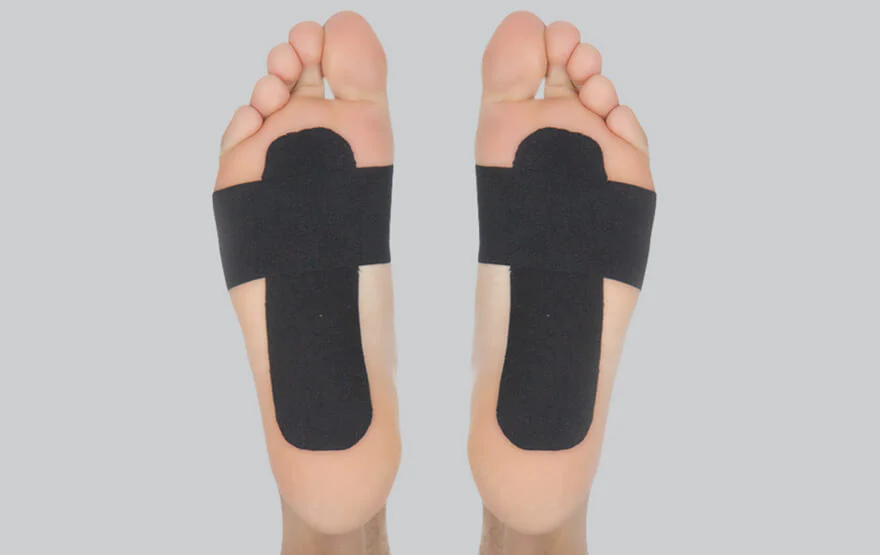
The point where the toes connect to the main part of the foot is called the ball. It’s a highly muscular area where a lot of athletes focus their efforts when competing.
Affected areas can twist easily, be subjected to severe impact, and become extremely painful if left untreated. This area also serves as the convergence of numerous minor muscles, bones, ligaments, tendons, and nerves. Elevation and balance are largely dependent on these extremely delicate and pliable components in the ball of the foot.
How Kinesiology Tape is Used
Kinesiology tape is useful for a variety of reasons. For advice on how to utilize the tape most effectively, your physical therapist can evaluate your condition as well as your current condition.
- Allowing motion: You can use kinesiology tape to help enhance the muscle contractions and contraction patterns of your muscles. Both normalized muscle tone and enhanced athletic performance may result from this.
- Inhibition and pain management: After an injury, kinesiology tape can be used to help reduce discomfort and potential muscle spasms. It could reduce the pain signals that your nerves send to the brain, which may lessen protective spasms and guard muscles in your body.
- Support and stability: Kinesiology taping can be appropriate for you if your condition requires holding a particular joint in place. Kinesiology tape can offer additional support for conditions like shoulder instability, iliotibial band friction syndrome, and patellofemoral stress syndrome. Your joint can be supported by the tape while maintaining some range of motion.
- Decreasing swelling: Kinesiology tape can help reduce swelling caused by surgeries or injuries by lowering pressure between the skin and underlying tissues. This creates a channel for more fluid to pass through. Kinesiology tape is sometimes applied to superficial contusions (bruises) or lymphedema management.
- Scar tissue management: It is possible to have scarring over the wounded area following surgery or other trauma. The skin and underlying fascia can sometimes get attached to the tissue behind a scar. The range of motion and typical mobility you have may be restricted by this scar tissue. The taut collagen that builds up scar tissue can be stretched over an extended period with minimal force by applying gentle pulls with kinesiology tape.
How Does KT Tape Work?
It’s difficult to try to imitate ligament function by taping the skin. The majority of tape is not as elastic as your ligaments. Your ligaments stretch to a certain point as you jump up and down, and then they stop. Their ability to stretch protects the ligament itself, and that hard halt guards the joint. Ankle taping is most commonly used to support the lateral (outside of the joint) ankle ligaments.
The calcaneofibular ligament travels nearly vertically, whereas the posterior and anterior talofibular ligaments travel horizontally. This is why the tape follows the same pattern as the ligaments marked in yellow in the previous image. These ligaments, which connect the foot and main leg bone (tibia) to the little outside ankle bone (fibula), can be compared to pieces of tape on the outside of your ankle.
Using regular cotton tape is like applying a cast of tape around the joint because it doesn’t stretch. On the other hand, KT Tape can be tight with little give or flexible and elastic. Flexible KT tape is practical for everyday use because it is also simple to remove from the skin.
Kinesio tape features
Kinesio tape is a flexible and elastic tape. The tape works best when you want extra support but still need ankle mobility of motion. Wearing kinesio tape might be appropriate if:
- you’re resuming your physical activity following an injury
- you are back to join sports activity
- you have injured ankles
Usually lasting up to five days, kinesio tape has a far longer adhesive life than sports tape. You can shower or take a bath while wearing the tape because of its waterproof characteristics and elastic nature, which often don’t impede blood flow.
Support accessories
Additionally, some people might employ specialized accessories to boost the tape’s efficacy and lessen any discomfort or consumption that it occasionally causes. For example, consider:
- Heel and lace pads, which are placed over the heel and on the top of the foot
- Taping Base Spray: This helps the tape stick to the skin more firmly by reducing friction.
- Pre-wrap: Before applying athletic tape, an elastic, stretchy wrap is applied to make the tape simpler to remove.
Kinesio taping steps for ankle stability:
Here we describe steps mainly to prevent ankle sprains. Like athletic tape, kinesio tape does not completely enclose the foot and ankle. Although there are several approaches, the following is a representation of a typical kinesio ankle-taping approach:
- Using a small piece of kinesio tape, begin 4 to 6 inches above the ankle on the outside. Take the strip of tape and cover the heel, pulling it to the other side and over the inside part of the ankle, stopping at the same level as the previous piece of tape to create a stirrup-like effect.
- Position a second piece of tape parallel to your Achilles tendon (heel) on the rear of your foot. Ring the foot with the tape by wrapping it around the ankle. So that the foot flexes and feels supported, the tape should be just tight enough.
- Some people cross the tape like an X over their ankle rather than circling it. To do this, position one end of a strip of tape in the middle of the lower leg beneath the arch, then bring the other end across the front to form an X. The tape’s ends are fastened behind the leg.
Steps for removing kinesio tape
It requires additional effort to remove Kinesio tape because it is meant to remain in place for several days. The following steps are among them:
- Put some oil-based products on the tape, like baby oil or cooking oil.
- After a few minutes, let this sit.
- In the direction that the hair grows, gently roll the tape’s edge downward and peel the tape away.
- You can use the oil to further dissolve any glue that remains after the tape has been removed.
How long do you leave KT Tape on?
For a maximum of five days, we advise not wearing it. In most cases, the location of the application determines how long it lasts. In general, tape stays on for two to three days when applied to areas like the knee or foot, which are naturally hard environments for tape.
FAQ
Does kinesiology tape boost athletic performance?
Some studies do show that using tape on injured areas can help reduce pain, but it’s unclear whether the pain reduction is significant. In healthy athletes, it improves performance.
Are there drawbacks to using kinesiology tape?
If you apply tape too tightly, it could result in blisters or rips in the skin. The effectiveness of the tape may be impaired if it is not applied correctly, both in terms of direction and stretch. The tape should be put on and you should be taught how by a professional.
Does KT Tape work for ankle pain?
KT is one of the functional treatment options for ankle sprain in TKM, which includes tape, a semi-rigid brace, and a lace-up brace
Is KT Tape better than an ankle brace?
Multiple studies have shown that tape is less effective than braces.
Is KT Tape good for swollen ankles?
Kinesio or sports tape can be used to tape an ankle to minimize swelling and offer stability. The correct way to do this can change according to the kind of tape you use. Ankle tape can give the ankle joint compression, stability, and support. It can lessen post-injury edema and assist avoid further damage to the ankle.
How long do you leave KT Tape on?
We advise avoiding wearing it for longer than five days. Normally, the taping time it lasts depends on where the tape is used. For example, when applying to a knee or foot which is naturally a harsh environment for tape, the tape will generally stay on for 2-3 days.
References
- Crna, R. N. M. (2020, January 29). 2 ways to tape an ankle. Healthline. https://www.healthline.com/health/how-to-tape-an-ankle#removing-tape
- Centeno, C., MD. (2020, September 6). 4 simple steps to wrap a sprained ankle with KT tape. Regenexx. https://regenexx.com/blog/ankle-taping/
- Taping an ankle sprain | Tape Geeks – TapeGeeks. (n.d.). https://tapegeeks.com/blogs/news/how-do-you-tape-for-lateral-ankle-sprain-and-how-to-prevent-it
- Eom, S. Y., Lee, W., Lee, J. I., Lee, E. H., Lee, H. Y., & Chung, E. J. (2014). The effect of ankle Kinesio taping on a range of motion and agility during exercise in university students. Physical Therapy Rehabilitation Science, 3(1), 63–68. https://doi.org/10.14474/ptrs.2014.3.1.63
- Slideshow: 7 exercises that work. (2022, September 15). MedicineNet. https://www.medicinenet.com/7_most_effective_exercises_slideshow/article.htm

